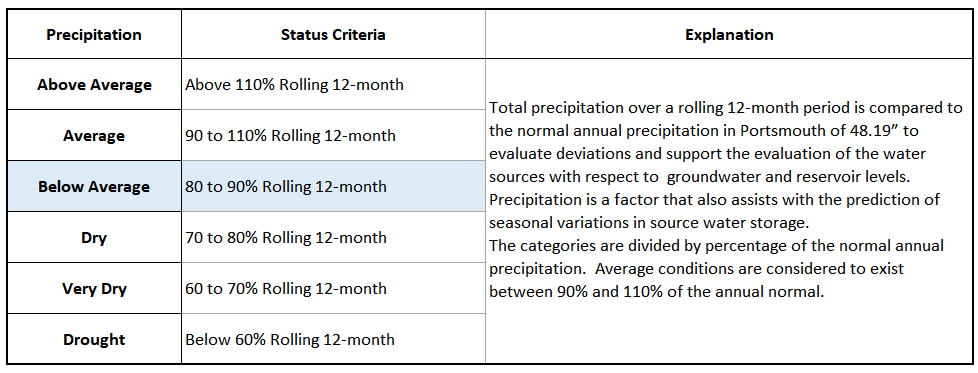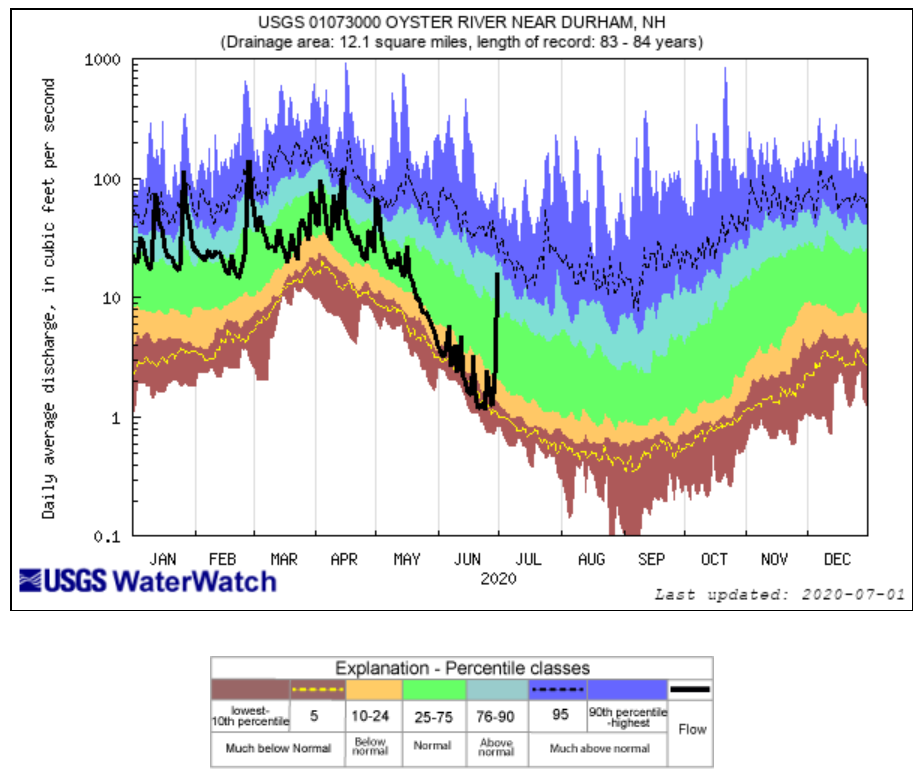Portsmouth Water Supply Status Report
July 1, 2020
MODERATE DROUGHT DECLARED
Due to the dry weather and below normal precipitation in May and most of June, the U.S. Drought Monitor elevated the southern half of the state to “Moderate Drought” conditions as of June 23, 2020. However, on June 30th Portsmouth received three inches of rain, which will help our conditions considerably. It also reduced water demand from a high of 6.15 million gallons delivered on June 21, 2020 to only 3.50 million gallons on June 30th.
The New Hampshire Department of Environmental Services is implementing the State Drought Management Plan to coordinate the State Drought Management Team of state, federal, regional and municipal agencies, including the Portsmouth DPW Water Division. Ongoing actions include: assessing reservoir impacts and adjusting operations, working with drinking water systems statewide and ensuring the public is informed of the impacts and conservation measures that should be employed now to avoid serious problems later in the summer. As more households are watering lawns and new flower vegetable gardens, the DPW Water/Stormwater Division encourages residents to “Think Blue” and consider some of these water-saving measures you can practice at home, click here.
Water use restrictions are currently not in effect. However, as the accompanying information shows, prior to the rainfall on June 30th, recent weather conditions have been very dry. This has caused lower than normal stream flows and recharge to our water supplies. If dry conditions persist, mandatory restrictions on non-essential water use may be required. They could include odd/even or two-days/week watering schedules.
We continue to ask our water customers to please use water wisely, minimize waste, and incorporate water efficient fixtures and appliances whenever possible.
Water operations staff continue to assess the supply conditions and will provide updates as needed.
Currently the Portsmouth and Pease Tradeport drinking water systems are able to meet the current water supply demands. City staff are continually monitoring the weather and our water supplies and will revise projections as needed.
Current Customer Water Demand
The following graphics show how water demands in our combined systems increased during the dry May and June period. The graphic on the right shows the effect of the rainfall on water demand near the end of June.
Precipitation Status
According to the Pease NOAA data, precipitation in Portsmouth was 3.85 inches in May, with three inches occurring on June 30th. Some locations in the City received higher volumes of rain on June 29th and 30th. The rain gauge we track at City Hall recorded over 5 inches of rain over this period of time. This is typical of the nature of the sporadic showers we can experience on the Seacoast in the summer. High volumes of water can fall in one area during a shower while, at the same time, little precipitation might fall just a few miles away. Typically, 4.19 inches of precipitation occurs in June. For the year so far, 2020 remains fairly dry with only April precipitation being above normal for the month.
Currently, precipitation over the past 12-months totals 40.79 inches, which is 85% of the mean annual amount of 48 inches.

To stay informed on the latest drought conditions and current drought related information go to the NHDES Drought Management Program webpage,
Groundwater Level
Currently the groundwater levels are considered Average. Groundwater levels in the Portsmouth and Greenland aquifers are at levels that are typical for this time of year and in some cases, a little bit above average. The groundwater levels in the Madbury wells are higher than average. By utilizing a greater proportion of surface water from the Bellamy Reservoir during the winter and spring, we have been able to reserve the groundwater for the drier summer period. We are entering the summer with considerable storage of groundwater.
Groundwater from wells in Madbury, Portsmouth and Greenland typically provide between 23% and 42% of the water supply to Portsmouth customers, with the remaining 58% to 77% from the Bellamy Reservoir. In May 2020, 44% of the supply came from wells, 56% from the reservoir.
River Flow
Portsmouth Water System operators track the USGS stream flow gauges in the Oyster River and Lamprey River to assess flow conditions. These gauged watersheds are used to assess the relative recharge to the Bellamy Reservoir through its tributaries, the Bellamy River and Mallego Brook.
The monthly mean May stream flow in the Oyster River at the USGS gauge was 18.6 cfs, which is 3.4 cfs (15%) lower than the 30-year May median flow rate of 22.0 cfs. The mean flow in June was tracking 75 to 95% lower than the 30-year June median flow rate until the rainfall on June 30th. The following graphic shows the effect of that rain. As of July 1st, flows are currently above normal due to this rainfall:

Reservoir Level
As the surface water source for the Madbury Water Treatment Facility, the Bellamy Reservoir is monitored to assess and predict the overall amount of water available for the Treatment Facility. Reservoir water levels are compared to typical monthly levels to assess the reservoir conditions.
The current stage of the reservoir is considered to be Average for this time of year. Water ceased flowing over the dam spillway on June 3rd. This is a month earlier that typical. It may begin flowing again in the future due to the recent rains.
Water flow past the dam is controlled by an outlet valve. The flow into the Bellamy River is adjusted to rates that correlate with the Oyster River flow rate. The reservoir currently has approximately 582 million gallons of water above the lower surface water intake.
Water Supply Capability
Water Supply Capability is a measure used to identify any issues with the Portsmouth Water Supply System that would result in a limitation to the amount of water that could be supplied. These could be lack of supply, issues with source water quality, or mechanical failures of system components.
The loss of the Haven Well as a water source (which contributed approximately 10% of the water system’s overall capability) has reduced the amount of water that can be provided to the system. As a result of this reduced capacity, the water supply capability is considered Below Normal at this time.
All of the other wells and the treatment facility are in excellent operational conditions, thus the water demand is currently being met with conservative protections and redundancy in the system. Average daily demand was 68% of the current system capability based on June data.
For more information, contact Brian Goetz, Deputy Director of Public Works at 766-1420 or Al Pratt, Water Resource Manager at 520-0622.
